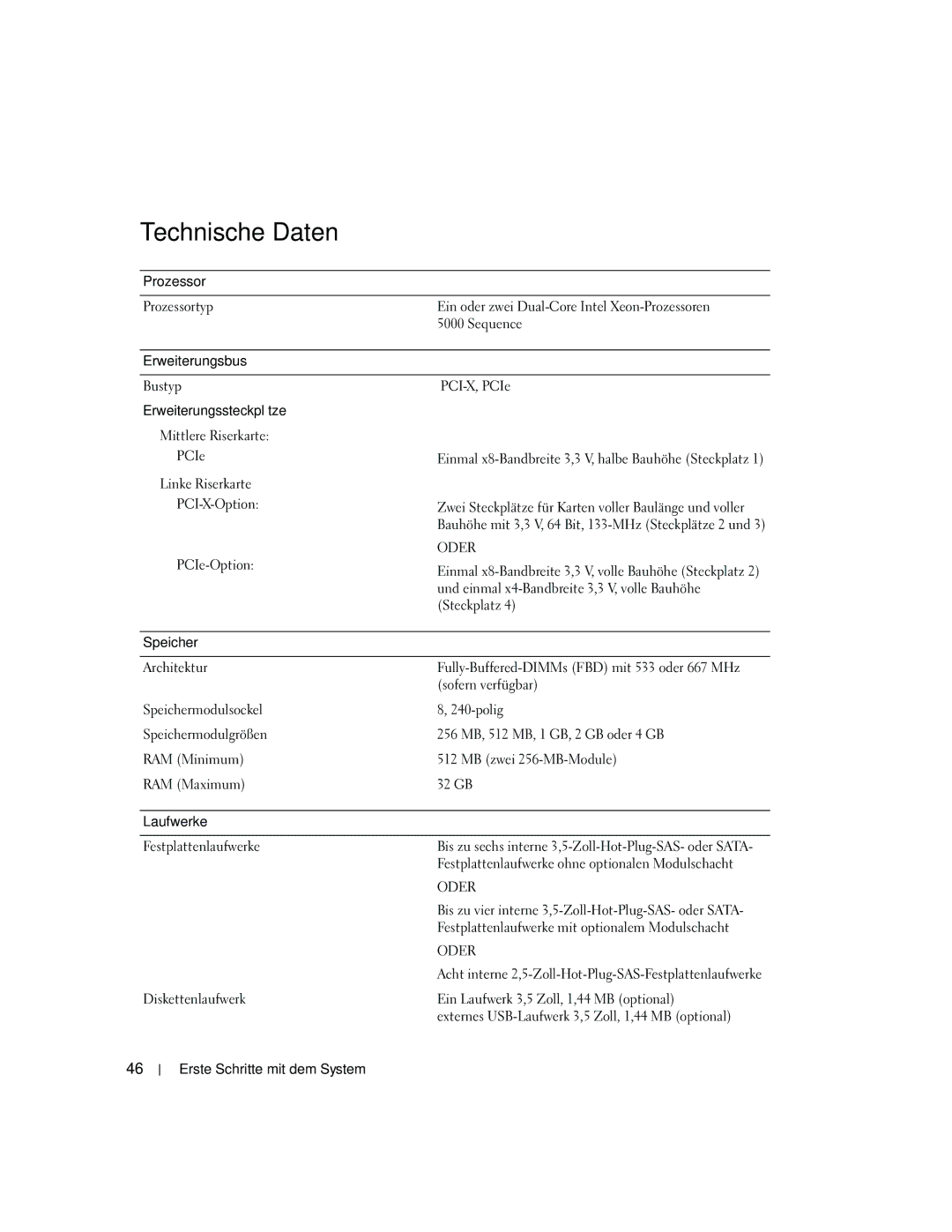Getting Started With Your System
W . d e l l . c o m s u p p o r t . d e l l . c o m
Page
Getting Started With Your System
November CD493
System Features
Getting Started With Your System
Supported Operating Systems
Other Information You May Need
Installing the Rails and System in a Rack
Unpacking the System
Connecting the Keyboard, Mouse, and Monitor
Connecting the Power
Connect the keyboard, mouse, and monitor optional
Installing the Power Cord Retention Bracket
Turning on the System
Complete the 0perating System Setup
Installing the Bezel
Install the bezel optional
Technical Specifications
Or combination CD-RW/DVD
Physical Rack Height
Začínáme se systémem
Poznámky, upozornění a výstrahy
Systémové funkce
Nebo
Podporované operační systémy
Další užitečné informace
Odborná pomoc
Instalace a konfigurace
Rozbalení systému
Instalace kolejniček a systému do stojanu
Připojení klávesnice, myši a monitoru
Připojení ke zdroji napětí
Instalace napájecích kabelů do retenčních svorek
Zapnutí systému
Dokončení nastavení operačního systému
Instalace čelního krytu
Technická specifikace
Nebo
MB DDR Sdram
Lithium-iontová baterie
Guide de mise en route
Remarques, avis et précautions
Caractéristiques du système
Guide de mise en route
Systèmes dexploitation pris en charge
Autres informations utiles
Installation des rails et du système dans un rack
Déballage du système
Connexion du clavier, de la souris et du moniteur
Connexion des cordons dalimentation
Connectez le clavier, la souris et le moniteur facultatif
Fixation du support du cordon dalimentation
Mise sous tension du système
Finalisation de linstallation du système dexploitation
Installation du cadre
Installez le cadre facultatif
Spécifications techniques
Carte de montage de gauche Option PCI-X
CD-RW/DVD tous deux en option
Maximal de 10C par heure
Erste Schritte mit dem System
Anmerkungen, Hinweise und Warnungen
Systemmerkmale
Oder
Unterstützte Betriebssysteme
Weitere nützliche Informationen
Installation der Schienen und des Systems in einem Rack
Auspacken des Systems
Anschließen von Tastatur, Maus und Bildschirm
Anschließen der Stromversorgung
Installation der Rückhalteklemme für das Netzstromkabel
Einschalten des Systems
Schalten Sie das System und den Bildschirm optional ein
Abschließen des Betriebssystem-Setups
Installieren Sie die Frontverkleidung optional
Anbringen der Frontverkleidung
Technische Daten
Linke Riserkarte PCI-X-Option
Ein optionales IDE-CD-, DVD- oder kombiniertes
CD-RW/DVD-Slimline-Laufwerk
Abmessungen und Gewicht
Τα πρώτα βήµατα Με το σύστηµά σας
Σηµείωση, Ειδοποίηση και Προσοχή
Χαρακτηριστικά συστήµατος
Τα πρώτα βήµατα Με το σύστηµά σας
Λειτουργικά συστήµατα που υποστηρίζονται
Άλλες πληροφορίες που ενδέχεται να χρειαστείτε
Λήψη τεχνικής βοήθειας
Εγκατάσταση και ρύθµιση παραµέτρων
Άνοιγµα της συσκευασίας του συστήµατος
Τοποθέτηση των ραγών και του συστήµατος σε ράφι
Σύνδεση πληκτρολογίου, ποντικιού και οθόνης
Σύνδεση της τροφοδοσίας
Καλωδίου της οθόνης
Ενεργοποίηση του συστήµατος
Παροχή τροφοδοσίας
Ρεύµατος PDU
Ενεργοποιήστε το σύστηµα και την οθόνη προαιρετικά
Ολοκληρώστε την εγκατάσταση του λειτουργικού συστήµατος
Τοποθέτηση της στεφάνης συγκράτησης
Τεχνικές προδιαγραφές
Γραµµής ή µια µονάδα συνδυασµού CD-RW/DVD
Υγρασίας 10% ανά ώρα
Rozpoczecie pracy z systemem
Uwagi, pouczenia i przestrogi
Funkcje systemu
Rozpoczecie pracy z systemem
Obslugiwane systemy operacyjne
Inne przydatne informacje
Uzyskiwanie pomocy technicznej
Instalacja i konfiguracja
Rozpakowanie systemu
Instalowanie prowadnic i systemu w stelazu
Podlaczenie klawiatury, myszy i monitora
Podlaczanie zasilania
Mocowanie wspornika podtrzymujacego kabel zasilania
Wlaczanie systemu
Zakonczenie konfiguracji systemu operacyjnego
Instalowanie ramki
Specyfikacja techniczna
Naped optyczny
Napedow CD-RW/DVD
Opcjonalny zewnetrzny naped CD USB
Pinowy, DTE, kompatybilny z
10 do 35C 50 do 95F przy maksymalnym
Godzine
Przy 3-200 Hz przez 15 min
Stronie systemu o sile 41 G az do 2 ms
Начало работы с системой
Примечания, замечания и предупреждения
Компоненты системы
Начало работы с системой
На системной плате имеются
Поддержка операционных систем
Дополнительная полезная информация
Распаковка системы
Установка направляющих кронштейнов и системы в стойку
Подключение клавиатуры, мыши и монитора
Подключение блока питания
Фиксация шнуров питания кронштейнами
Включение системы
Завершение настройки системы
Установка лицевой панели
Технические характеристики
Шина расширения
Примечание Устройства DVD
Электропитание продолжение
Procedimientos iniciales con el sistema
Notas, avisos y precauciones
Características del sistema
Procedimientos iniciales con el sistema
Instalación y configuración
Sistemas operativos compatibles
Otra información necesaria
Obtención de asistencia técnica
Desembalaje del sistema
Instalación de los rieles y del sistema en un rack
Conexión del teclado, el ratón y el monitor
Conexión de la alimentación
Conecte el teclado, el ratón y el monitor opcional
Encendido del sistema
Encienda el sistema y el monitor opcional
Configuración del sistema operativo
Instalación del embellecedor
Instale el embellecedor opcional
Especificaciones técnicas
Opción PCIe
De CD-RW/DVD combinada
Máxima de 10 C por hora
תכרעמה םע הדובעה תליחת
הביבס יאנת קד 15 3-200 Hz ב 0.25 G קד 15 3-200 Hz ב 0.5 G
048 10,600
הבוג הלעפה 109 תכרעמה םע הדובעה תליחת
חתמ
חוכ קפס לכל חז חוכ קפס
750 W קפסה
ילמשח חתמ
לדוגב SATA, וא SAS גוסמ חישק ילנויצפוא הידמ את אלל ימינפ
וא DVD ,IDE ירוטילקתל קד ילנויצפוא יטפוא בלושמ CD-RW/DVD
DVD ינקתה הצע
תוטלק
ילאמש riser
MHz ,תויביס 64 ,3.3-V ,אלמ ילנויצפוא PCI-X דחא V ילולסמ
ילנויצפוא PCIe
יוסיכה חול תנקתה
אלש תונכותו הרמוח
105 תכרעמה םע הדובעה תליחת
למשחה לבכ לע הנגהל ןתיווזה תנקתה
תכרעמה תקלדה
למשחה לבכ תא
גצהו רבכעה ,תדלקמה רוביח
למשחה רוביח
103 תכרעמה םע הדובעה תליחת
הזיראהמ תכרעמה תאצוה
דמעמב תכרעמהו תוליסמה תנקתה
אכ Novell NetWare
101 תכרעמה םע הדובעה תליחת
PCIe Riser card
PCI-X 3.3-V יצירח ינש ללוכה ילאמש riser card
RAID רקב סיטרכ וא SAS לש בלושמ חראמ קיפאל ידועיי
Mbps לש
MHz וא
Serial Attached Scsi SAS גוסמ
ילנויצפואה הידמה את
44-MB חפנב לדוגב
תורהזאו תורעה ,תוצע
Dell PowerEdge 2950 תוכרעמ

